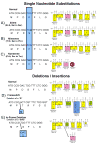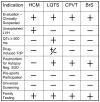Genetic testing for potentially lethal, highly treatable inherited cardiomyopathies/channelopathies in clinical practice
- PMID: 21382904
- PMCID: PMC3073829
- DOI: 10.1161/CIRCULATIONAHA.109.914838
Genetic testing for potentially lethal, highly treatable inherited cardiomyopathies/channelopathies in clinical practice
Conflict of interest statement
Figures








Similar articles
-
Personalized medicine: genetic diagnosis for inherited cardiomyopathies/channelopathies.Rev Esp Cardiol (Engl Ed). 2013 Apr;66(4):298-307. doi: 10.1016/j.rec.2012.12.010. Epub 2013 Feb 26. Rev Esp Cardiol (Engl Ed). 2013. PMID: 24775620 Review.
-
Genetic basis of channelopathies and cardiomyopathies in Hong Kong Chinese patients: a 10-year regional laboratory experience.Hong Kong Med J. 2018 Aug;24(4):340-349. doi: 10.12809/hkmj176870. Epub 2018 Mar 2. Hong Kong Med J. 2018. PMID: 29497013
-
HRS/EHRA expert consensus statement on the state of genetic testing for the channelopathies and cardiomyopathies this document was developed as a partnership between the Heart Rhythm Society (HRS) and the European Heart Rhythm Association (EHRA).Heart Rhythm. 2011 Aug;8(8):1308-39. doi: 10.1016/j.hrthm.2011.05.020. Heart Rhythm. 2011. PMID: 21787999 No abstract available.
-
HRS/EHRA expert consensus statement on the state of genetic testing for the channelopathies and cardiomyopathies: this document was developed as a partnership between the Heart Rhythm Society (HRS) and the European Heart Rhythm Association (EHRA).Europace. 2011 Aug;13(8):1077-109. doi: 10.1093/europace/eur245. Europace. 2011. PMID: 21810866 No abstract available.
-
Establishment of Specialized Clinical Cardiovascular Genetics Programs: Recognizing the Need and Meeting Standards: A Scientific Statement From the American Heart Association.Circ Genom Precis Med. 2019 Jun;12(6):e000054. doi: 10.1161/HCG.0000000000000054. Epub 2019 May 23. Circ Genom Precis Med. 2019. PMID: 31117808
Cited by
-
Heart failure: advanced development in genetics and epigenetics.Biomed Res Int. 2015;2015:352734. doi: 10.1155/2015/352734. Epub 2015 Apr 9. Biomed Res Int. 2015. PMID: 25949994 Free PMC article. Review.
-
Genetic testing in heritable cardiac arrhythmia syndromes: differentiating pathogenic mutations from background genetic noise.Curr Opin Cardiol. 2013 Jan;28(1):63-71. doi: 10.1097/HCO.0b013e32835b0a41. Curr Opin Cardiol. 2013. PMID: 23128497 Free PMC article. Review.
-
Almanac 2011: Cardiac Arrhythmias and Pacing. The National Society Journals Present Selected Research that has Driven Recent Advances in Clinical Cardiology.Mater Sociomed. 2011;23(3):147-60. doi: 10.5455/msm.2011.23.147-160. Mater Sociomed. 2011. PMID: 23922508 Free PMC article. No abstract available.
-
HRS policy statement: clinical cardiac electrophysiology fellowship curriculum: update 2011.Heart Rhythm. 2011 Aug;8(8):1340-56. doi: 10.1016/j.hrthm.2011.06.008. Epub 2011 Jun 14. Heart Rhythm. 2011. PMID: 21699868 Free PMC article. No abstract available.
-
Genetics of hypertrophic cardiomyopathy: advances and pitfalls in molecular diagnosis and therapy.Appl Clin Genet. 2014 Oct 3;7:195-208. doi: 10.2147/TACG.S49126. eCollection 2014. Appl Clin Genet. 2014. PMID: 25328416 Free PMC article. Review.
References
-
- Nussbaum RLMR, Willard HF. Thompson & Thompson Genetics in Medicine. 6. Philadelphia, Pa: WB Saunders Co; 2001. pp. 51–94.
-
- den Dunnen JT, Antonarakis SE. Nomenclature for the description of human sequence variations. Human Genetics. 2001;109(1):121–124. - PubMed
-
- Tester DJ, Will ML, Haglund CM, Ackerman MJ. Compendium of cardiac channel mutations in 541 consecutive unrelated patients referred for long QT syndrome genetic testing. Heart Rhythm. 2005;2(5):507–517. - PubMed
-
- Tester DJ, Ackerman MJ. Genetic Testing. In: Gussak I, Antzelevitch C, editors. Electrical diseases of the heart: genetics, mechanisms, treatment, prevention. London: Springer; 2008. pp. 444–458.
-
- Miller TE, Estrella E, Myerburg RJ, Garcia de Viera J, Moreno N, Rusconi P, Ahearn ME, Baumbach L, Kurlansky P, Wolff G, Bishopric NH. Recurrent third-trimester fetal loss and maternal mosaicism for long-QT syndrome.[see comment] Circulation. 2004;109(24):3029–3034. - PubMed
Publication types
MeSH terms
Grants and funding
LinkOut - more resources
Full Text Sources
Medical

